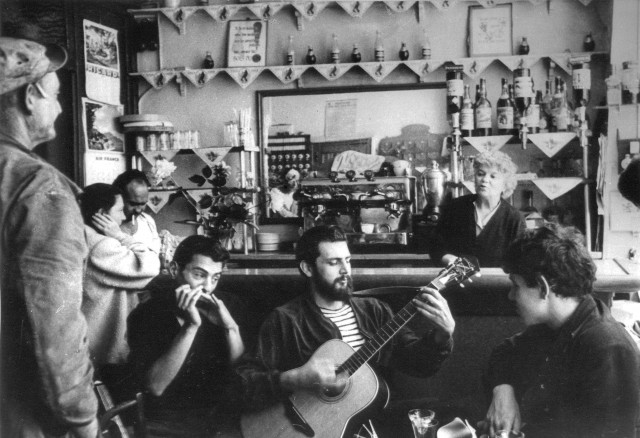
Documentary examines Paris hotel where the Beat Generation came to live and play between 1957 and 1963 (photo by Harold Chapman, 1960)
THE BEAT HOTEL (Alan Govenar, 2011)
Cinema Village
22 East 12th St. between University Pl. & Fifth Ave.
Opens Friday, March 30
212-924-3363
www.thebeathotelmovie.com
www.cinemavillage.com
 Between 1957 and 1963, a group of American Bohemians moved to Paris in the wake of obscenity trials against the publication of Allen Ginsberg’s Howl, settling into a cheap, dirty, nameless hotel in the Latin Quarter run by a woman known as Madame Rachou. Soon christened the Beat Hotel, the site became home to such writers, artists, and poets as Ginsberg, Peter Orlovsky, Gregory Corso, William S. Burroughs, Ian Somerville, and Brion Gysin. “The Beat Hotel was a temple of the mind,” resident and artist Elliot Rudie says early on in Alan Govenar’s The Beat Hotel, a new documentary that examines the history and influence of that time. “Once you went through the door into the hotel, you were in another world,” adds photographer Harold Chapman, who took subtle pictures that capture the flavor and essence of what went on at the hotel, where Burroughs finished Naked Lunch, Corso wrote Bomb, and Ginsberg began Kaddish. The eighty-two-minute film features recollections from some of the hotel’s former residents, including Chapman, artist Jean-Jacques Lebel, and Rudie, whose art inspired animations used in the documentary, in addition to book dealers Cyclops Lester and George Whitman, who hung out with the Beats while they were in Paris. Govenar fills in the details with talking heads and reenactments of important scenes, supplemented by Chapman’s photographs. Among the more entertaining stories is one of Corso cutting off Marcel Duchamp’s tie at a party. Although the film never quite achieves the liveliness of the Beat Generation that it seeks to evoke, it is still an interesting look inside a wonderfully creative and fascinating period in twentieth-century literature and the counterculture movement.
Between 1957 and 1963, a group of American Bohemians moved to Paris in the wake of obscenity trials against the publication of Allen Ginsberg’s Howl, settling into a cheap, dirty, nameless hotel in the Latin Quarter run by a woman known as Madame Rachou. Soon christened the Beat Hotel, the site became home to such writers, artists, and poets as Ginsberg, Peter Orlovsky, Gregory Corso, William S. Burroughs, Ian Somerville, and Brion Gysin. “The Beat Hotel was a temple of the mind,” resident and artist Elliot Rudie says early on in Alan Govenar’s The Beat Hotel, a new documentary that examines the history and influence of that time. “Once you went through the door into the hotel, you were in another world,” adds photographer Harold Chapman, who took subtle pictures that capture the flavor and essence of what went on at the hotel, where Burroughs finished Naked Lunch, Corso wrote Bomb, and Ginsberg began Kaddish. The eighty-two-minute film features recollections from some of the hotel’s former residents, including Chapman, artist Jean-Jacques Lebel, and Rudie, whose art inspired animations used in the documentary, in addition to book dealers Cyclops Lester and George Whitman, who hung out with the Beats while they were in Paris. Govenar fills in the details with talking heads and reenactments of important scenes, supplemented by Chapman’s photographs. Among the more entertaining stories is one of Corso cutting off Marcel Duchamp’s tie at a party. Although the film never quite achieves the liveliness of the Beat Generation that it seeks to evoke, it is still an interesting look inside a wonderfully creative and fascinating period in twentieth-century literature and the counterculture movement.